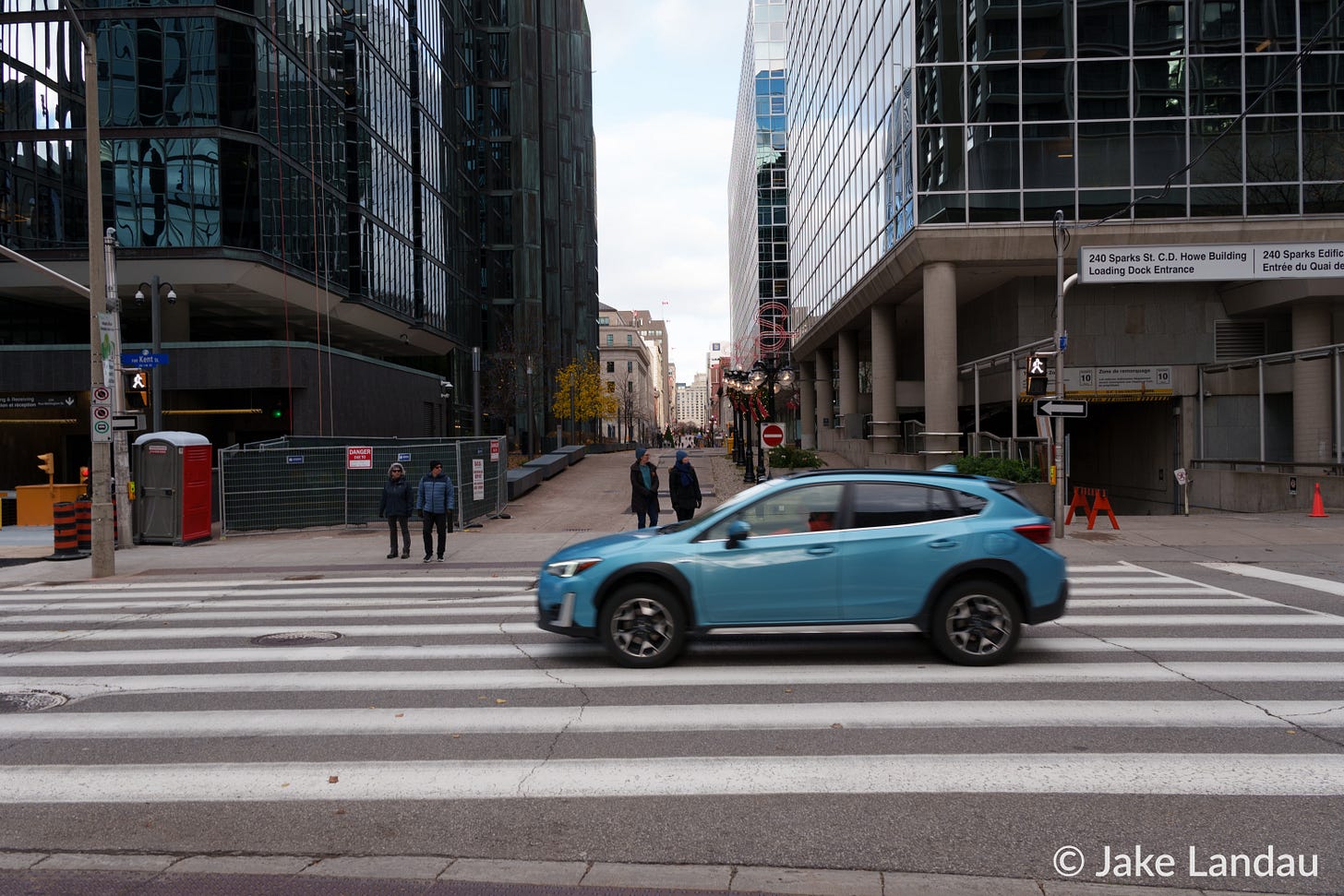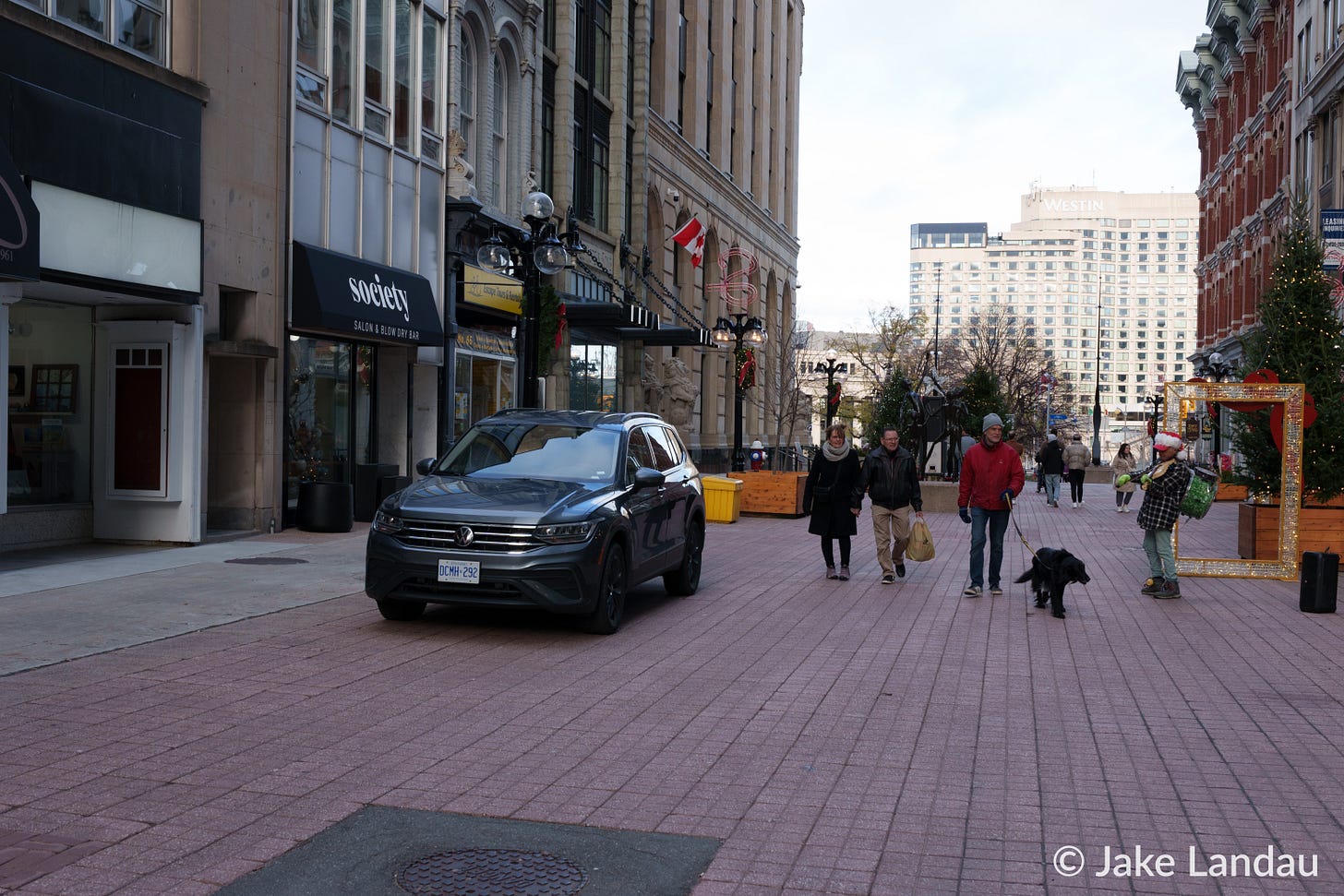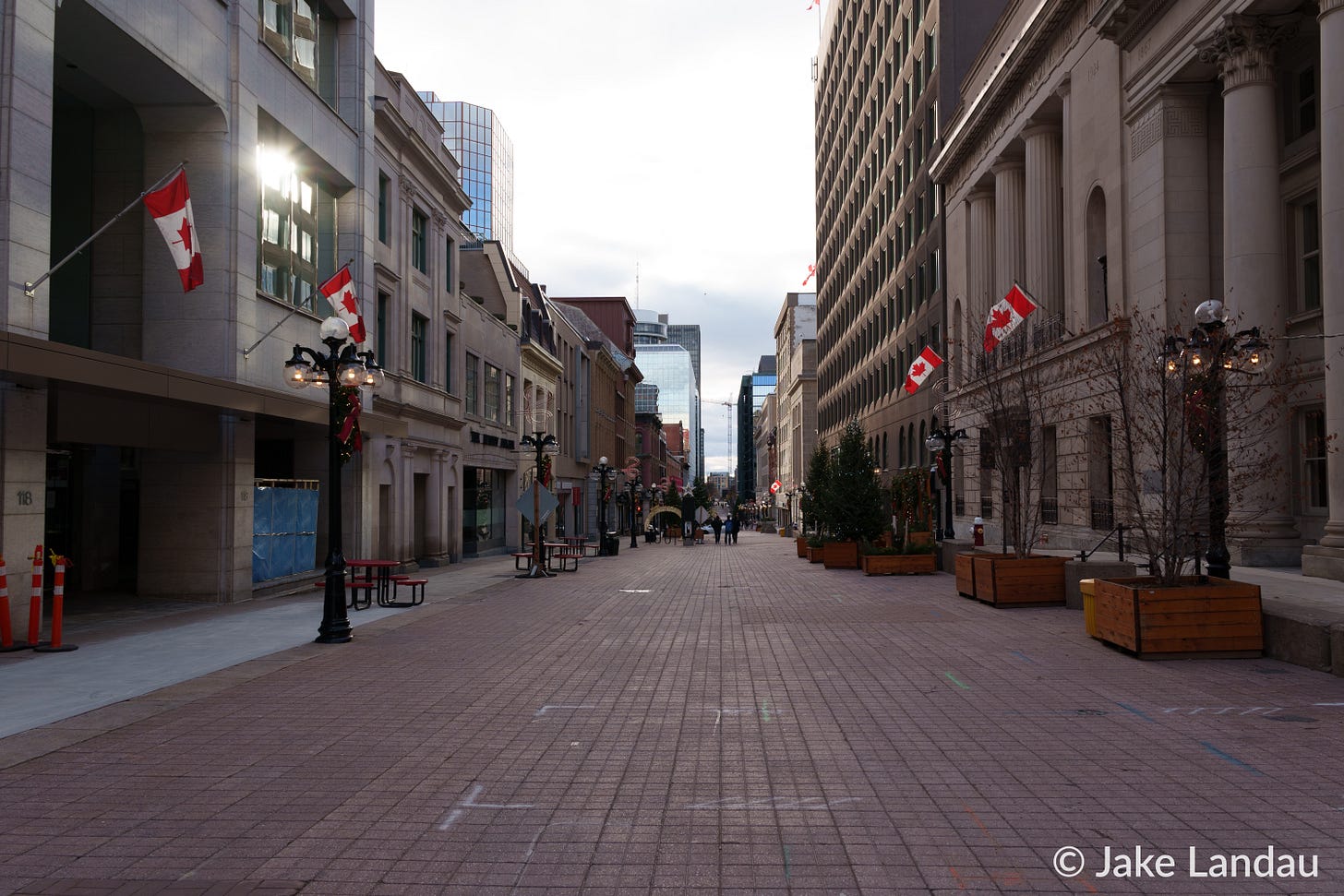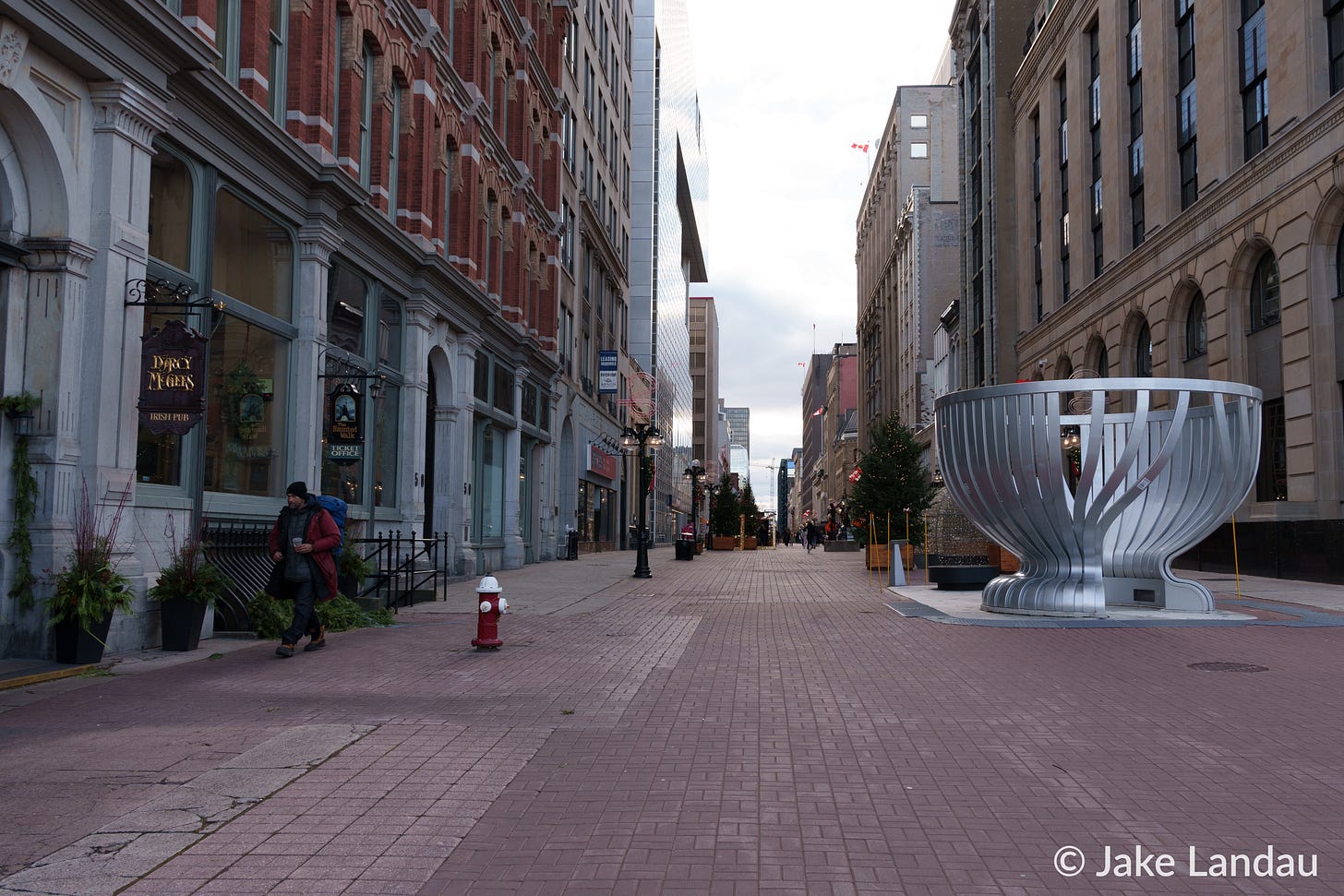Normally, I love pedestrian malls. Why is Ottawa's Sparks Street so uniquely bad?
My sincere praise to Ottawa, on their ability to ruin literally any good idea.

The pedestrian mall as a concept is the Platonic ideal of the urbanist fantasy. Who amongst us does not dream of this utopian vision? In our war on the car, the pedestrian mall is the ultimate victory, in which we banish the motorists to the Shadow Realm.
And yet, in Canada’s capital city of Ottawa, this thesis does not hold. Confusingly, theory has translated to praxis in most pedestrian areas; they’re exceedingly popular in Montréal, where dozens of streets are pedestrianized every summer.
Has Ottawa, in the grand tradition of their city, grasped defeat from the jaws of victory once more? Have they taken something almost universally beneficial, and somehow made it truly suck?
The answer, dear reader, is yes. In Ottawa? The answer is always, always, yes.
The pedestrianized portion of Sparks Street consists of five segments, bounded between Lyon Street North on the west and Elgin Street on the east. Technically, the “Sparks Street Mall”, in proper terms, only consists of the eastern three segments, but all five blocks share a degree of continuity as a pedestrianized zone.
A degree, being the operative word, because in Ottawa’s enlightened wisdom, each segment of pedestrianized street is divided by a car intersection. Furthermore, Kent Street, O’Connor Street, and Metcalfe Street are one-way roads, on which drivers typically drive at higher, more lethal speeds.
Excruciatingly, the lights stay green for extended periods of time before allowing pedestrians to cross. As a result, many Ottawans cross when there’s a break in traffic, regardless of whether the lights are red or green.
Even when the light does turn red and the crosswalk sign says go, expect Ottawa motorists to speed right through anyways. It is dangerous, and you need to keep your wits about yourself every time you cross between segments.
With all of this put together, Sparks Street is best described not as a single pedestrian mall, but rather five miniature ones, split apart by real-life games of Crazy Taxi for the Sega Dreamcast.

This creates a hostile experience, where east-west movement becomes just as slow as normal car-dominated roads. It is further aggravating, because these north-south roads should be closed between Wellington Street and Sparks Street anyway.
After all, the Federal Government sought to purchase Wellington between Bank Street and Elgin Street so that they could permanently close it to cars. This was motivated by the security concerns triggered by the Freedom Convoy terror movement and their coup d’état attempt.
Instead, the perpetual villain of Ottawa’s people, Mayor Mark Sutcliffe, decided to reopen Wellington against these concerns. Admittedly, I gained a little schadenfreude from watching Liberal MP Yasir Naqvi, who endorsed Sutcliffe, yet also called for the closure of Wellington Street, express dismay at Sutcliffe’s decision.

Mark Sutcliffe will be gone eventually, and a new mayor will hopefully make better decisions. Wellington Street should be permanently pedestrianized, as should the portions of Kent Street, Bank Street, O’Conner Street and Metcalfe Street which break up the five segments of the Sparks Street pedestrianized area.
Using retractable bollards, these areas could be made accessible to emergency vehicles, while being kept closed to normal car traffic. This would actually make emergency vehicle response times faster, and save lives!
But even with the pedestrianization being fully optimized to this degree, there is still a core issue with Sparks Street, and it has nothing to do with infrastructure. The Sparks Street Mall must deal with a landlord problem.
It is remarkably striking just how early everything closes on Sparks Street…if there’s even a business to open and close. The pedestrian mall is littered with “for lease” signs, and it’s not hard to imagine why those storefronts are vacant when the lease terms appear to have strings attached.
The majority of the buildings on the northern side of Sparks Street are owned directly by the Federal Government, while the properties on the southern side are largely owned by the National Capital Commission.
While the distinction between the two may appear thin, in practice the southern half of the mall has more active storefronts at ground level. While vacancies on the southern half are widespread, at least there are storefronts to be vacant; the northern half frequently consists of blank walls without amenities, while the southern half is where every liquor-licensed pub is located.

This is exemplified most at the western end, starting with the first block of Sparks Street, from Lyon Street to Kent Street. On the northern side, the Department of Justice takes up the vast majority of the space, with the only ground-level amenities a salon that closes after the workday, and a café which closes as early as 14h30.
On the southern side, the Place de Ville office complex keeps their amenities internal, depopulating Sparks Street at the ground level. Accessible from the street is a Starbucks which closes at 16h00 on weekdays and 13h00 on weekends. The only amenity on this block open past the workday period is a restaurant in the Marriott, open until 23h00 in the evening.
A similar pattern repeats the next segment eastward, from Kent Street to Bank Street. That street’s eponymous Bank of Canada takes up the entire northern half of this segment of Sparks Street, with the only public use being the Bank of Canada Museum. Even that museum is only open until 17h00, and only from Thursday to Monday.
On the southern half of this second block of Sparks Street, the 240 Sparks Street complex has plenty of amenities, including food, medical clinics, and a pharmacy. However, all of these are buried within the building, inaccessible to the ground level, and close with the workday schedule.
The sole ground-level amenity on this segment, much like the last block, is a pub, which has the grace of being open until 23h00 at night. Sparks Street will become moderately more lively on the next segment, bounded from Bank to O’Connor.
The north side of this middle block contains the Wellington and Sir John A. Macdonald Buildings, which serve the Federal Government as office space; at the ground level are several empty storefronts, as well as an optometrist and a salon, both of which are only open during workdays.

But on the southern side, there are actual ground-level amenities directly accessible to the public. There are a variety of pubs and restaurants, which have closing hours ranging from 21h00-23h00, as well as a 24-hour gym. The statue of Terry Fox which formerly resided on Wellington Street is also now homed here.
However, much of the space is also taken up by CBC/Radio-Canada’s Ottawa office, which is effective dead space for the general public. Additionally, the Winners department store is only open until 19h00; it would frankly be better suited to the Rideau Centre than this kind of street.
The penultimate segment of Sparks Street runs from O’Connor to Metcalfe, and possesses a similar energy to the previous segment. On both sides of the street there are food joints, clothing stores, a dentist and an optometrist, as well as a hotel, a café, a bank, and a souvenir store.

All of these, however, have the same weakness; they close almost immediately after the workday’s conclusion, and become effective dead space from the pedestrian perspective. This portion of the street is popular only at the best times; otherwise, it lies abandoned.
Finally, the Sparks Street Mall ends between Metcalfe Street and Elgin Street, with a collection of artistic statues that attract tourists for photos. Again, there are souvenir shops, food options, a bank, a bike shop, and tour guides, and also a post office. But all of these, yet again, close with the workday.
At the very tip of Sparks Street’s southeastern edge lies D’arcy McGee’s, the watering hole of Ottawa’s politicos. This bar serves staffers and lobbyists alike, and as a result shutters operations early at 23h00, except for extended Friday and Saturday hours. This is rather pale in comparison to every bar which run further south down Elgin.
From end-to-end of Sparks Street, there are a few recurring themes:
Federal office buildings that have zero public-facing amenities at ground level
Tenants who occupy ground-level retail with low-demand businesses that attract few customers
Few popular attractions, which are sabotaged by early closing times

The Federal Government has been a terrible steward for this area, whether it be their directly-owned office buildings, or the retail properties managed by the National Capital Commission. The fact that last call for bars comes earlier on Sparks Street makes these bars utterly incapable of competing with Elgin Street.
Truly, there little on this street that would attract the public interest. It does not surprise me that OCTranspo’s Line 1 metro is instead one block south on Queen Street. There is very little for the working class of Ottawa on Sparks Street, only things for the political class.
Ultimately, this is the problem that Sparks Street faces; this is why it has been a failure of Ottawa’s urban planning. Sparks Street serves as nothing but a playground for staffers and lobbyists, to hold their cinq à septs and venerate the oppresive status quo.
The main argument that MPs made for closing Wellington was the benefits it would bring Parliament, rather than the benefit it would provide the public. And yes, it would be of great benefit to the public!
But in adopting the perspective of self-interest rather than public benefit, they gave Mark Sutcliffe an easy opportunity to reject their request, and shore up populist sentiment against the Federal Government.

Is it any shock, that ByWard Market and Elgin Street, despite being far more hostile to pedestrians, attract far more people? They have things which people actually want to do, and they have those things open at the hours people want to go do them!
Federal politicians, federal staffers, and federal lobbyists need to understand something; Centretown does not exist for their pleasure alone. Parliament Hill is an important part of downtown, true, but ultimately the people of Centretown should come first and foremost.
If the Federal Government can’t be a good landlord for Sparks Street, it needs to hand the reigns to someone with Ottawa’s best interests at heart. That certainly isn’t Mark Sutcliffe, but right now, the Federal Government is choking Sparks Street Mall to death.
Because until Sparks Street has actual reasons for people to go there, things to capture the interest of Ottawans and tourists alike?
It will remain nothing but a monument to Ottawa’s mediocrity, and their ability to ruin even the most wonderful ideas.



One of the worst things about Sparks Street is that it has given the whole idea of pedestrianized streets a terrible name in Ottawa. In my opinion, a sizeable chunk of the Market should be permanently closed to cars, but people will say “Yeah, because that’s worked so well on Sparks.” It’s infuriating. There isn’t another large city in Canada with such an imagination deficit as Ottawa.
Ottawa is an oddball place. I want to like it, but the city center is always strangely empty. We were in town for a wedding a couple summers ago and walked the entirety of Sparks Street on a beautiful warm Friday evening looking for a restaurant and found nothing except that single pub jammed with government bureaucrats drinking away their sorrows. We just kept walking and walking until we got to the Byward and had a nice meal there.
On Sparks Street I get a vibe of what Toronto's finance district was like when I worked there in the 90s, when all the shops and restaurants shuttered by 4 or 5pm, and then it became a ghost town after mad rush to the Union GO trains. Byward is lively but alarmingly scruffy, like Kensington Market before the hipsterization.
My best theory is that Ottawa is not really a city, and I don't mean that negatively, actually I think it's the reason a lot of Canadians seem to like it, because most Canadians hate big cities. Ottawa is basically a largeish town with enormous suburbs. I know many people who have moved to the area over the years and they have a high quality of life, but they all live in the far suburbs and drive to green spaces for recreation. The city core is just a restaurant destination once in a blue moon, also driven to and from. There's just not enough to give the core the vibrancy a city needs to feel less desolate and be really livable without a car.
And the traffic out to Orleans from the city center or the train station blows my mind every time, and I'm from Toronto. How can it be so bad? And don't get me started on the abysmal process of obtaining a car rental from that train station. At least the LRT provides some options now, when its doors are not frozen shut.